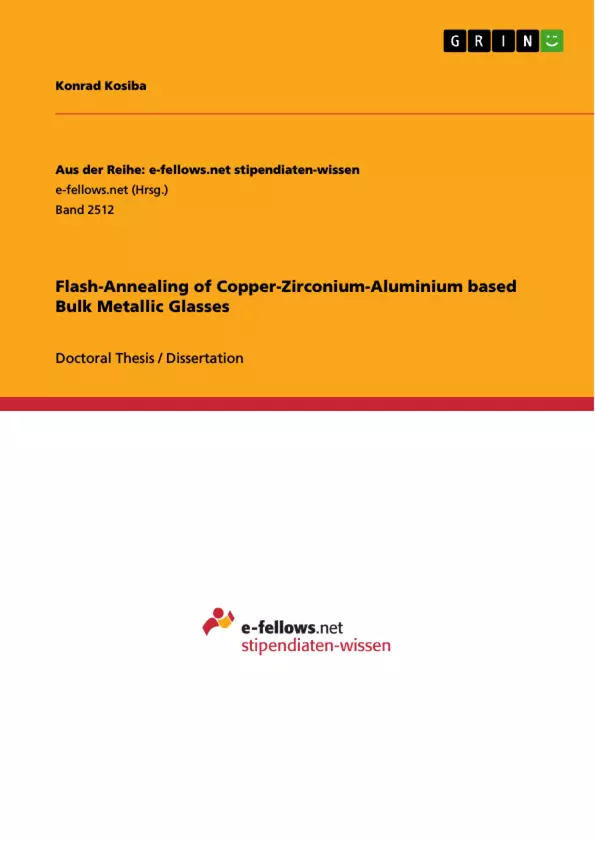The first aim of the present work is to design, built and test a device being capable of rapidly heating and subsequently immediately quenching bulk metallic glass (BMG) specimens in a uniform and reproducible manner. The heating and ejection process of the BMG specimen is temperature-controlled, so that the heating rate and temperature to which the BMG is annealed to, can be varied.
BMG composites consisting of B2 CuZr crystalline particles embedded in the glass shall be prepared. The occurrence of the shape-memory B2 CuZr phase and a good glass-forming ability limit the selection of the alloy system to Cu-Zr-Al. The high-temperature B2 CuZr phase is metastable at room temperature, yet rapid cooling of Cu-Zr-Al-based alloys enables to cast B2 CuZr BMG composites. One could speculate that the B2 CuZr phase forms as well during the devitrification of Cu-Zr-Al-based metallic glass at high heating rates. Indeed, a recent work yields hope rendering the preparation of B2 CuZr BMG composites by devitrification possible. Therefore, a rapid heating or flash-annealing device as it is termed here, is developed first. Thereby, flash-annealing is defined as rapid heating to a predefined temperature followed by immediate quenching. Cu-Zr-Al-based BMGs are flash-annealed at different heating rates to temperatures above the crystallization temperature and the influence of the heating rate on the phase formation shall be unravelled. The exact ejection temperature of the BMG specimen determines the volume fraction of the crystalline phase(s) and the crystal size distribution of the so-obtained composite. The immediate subsequent quenching at a high cooling rate is crucial here, since the partially crystallized supercooled liquid must be frozen in. The mechanical properties of the BMG composites and deformation mechanisms involved are studied. Moreover, the microstructure of these BMG composites allows to gain knowledge about crystallization kinetics of highly supercooled liquids during rapid heating.
Inhaltsverzeichnis (Table of Contents)
- Abstract
- Objectives
- Fundamentals
- Structure of metallic glass
- Glass formation and crystallization
- Glass transition
- Classical nucleation theory
- Crystal growth in undercooled liquids
- Isothermal and isochronal devitrification of metallic glasses
- Fragility concept
- Glass-forming ability
- Mechanical properties
- Deformation of bulk metallic glass
- Measures to affect the plasticity of bulk metallic glass
- Cu-Zr-Al-based alloys
- Flash-annealing
- Experimental
- Sample preparation
- X-ray diffraction
- Calorimetry
- Flash-annealing
- Electro-static levitation
- Microscopy
- Mechanical testing
- Optical profilometry
- Results and Discussion
- Development of the flash-annealing device
- Description of the temperature-time heating curve
- Inductive heating
- Estimation of the cooling rate
- Surface oxidation of Cu-Zr-Al-based BMGs during flash-annealing
- Characterization of the as-cast bulk metallic glasses
- Development of the Cu44Zr44Al8Hf2Co2 alloy
- Amorphicity of the Cu46Zr46Al8 and Cu44Zr44Al8Hf2Co2 BMGs
- Mechanical behaviour of as-cast Cu44Zr44Al8Hf2Co2 BMGs
- Structural changes during flash-annealing below Tx
- Calorimetric investigation of structural changes
- Mechanical properties of flash-annealed bulk metallic glass
- Crystallization of BMGs during flash-annealing
- Phase formation of Cu-Zr-Al-based BMGs
- Crystallization kinetics of Cu-Zr-Al-based BMGs
- Mechanical behaviour of Cu44Zr44Al8Hf2Co2 BMG composites
- Development of the flash-annealing device
- Summary
- Outlook
Zielsetzung und Themenschwerpunkte (Objectives and Key Themes)
This dissertation investigates the structural changes of Cu-Zr-Al-based bulk metallic glasses (BMGs) induced by rapid heating. The main objective is to develop a flash-annealing device capable of rapidly heating BMGs to predefined temperatures followed by instantaneous quenching. The study then examines the structural and mechanical properties of the BMGs after flash-annealing.
- Influence of flash-annealing on the structure of metallic glasses, including relaxation, rejuvenation, and the growth of quenched-in nuclei.
- Impact of flash-annealing on the mechanical properties of BMGs, particularly their plasticity and ductility.
- Investigation of crystallization kinetics of Cu-Zr-Al-based BMGs during rapid heating, focusing on transient nucleation effects.
- Development of a novel method for preparing BMG composites with tailored microstructures by flash-annealing and subsequent quenching.
- Correlation between microstructural parameters (crystal size, volume fraction, and distribution) and the mechanical properties of BMG composites.
Zusammenfassung der Kapitel (Chapter Summaries)
Chapter 3 introduces the fundamental concepts and theories relevant to the study of metallic glasses. It covers the structure of metallic glasses, including short-range order (SRO) and medium-range order (MRO). The chapter then discusses glass formation, crystallization, and the fragility concept, which helps classify glass-forming liquids based on their temperature dependence of viscosity. It also delves into the mechanical properties of BMGs, including their deformation mechanism and the measures taken to improve their plasticity. Chapter 4 outlines the experimental methods used in the dissertation. It covers sample preparation, X-ray diffraction, calorimetric analysis, flash-annealing setup and operation, electrostatic levitation, microscopy techniques, and mechanical testing methods. Finally, Chapter 5 presents the results of the research. It starts by discussing the development and characterization of the flash-annealing device. The chapter then explores the effects of flash-annealing on the structural state of Cu-Zr-Al-based BMGs, including relaxation, rejuvenation, and the growth of quenched-in nuclei. The final section examines the crystallization kinetics of BMGs during flash-annealing, focusing on transient nucleation effects, and explores the mechanical properties of BMG composites prepared by flash-annealing.
Schlüsselwörter (Keywords)
The dissertation focuses on the study of bulk metallic glasses (BMGs), flash-annealing, crystallization kinetics, transient nucleation, mechanical properties, and BMG composites. The research investigates the influence of rapid heating on the structure and properties of Cu-Zr-Al-based BMGs, particularly concerning the development of a novel method for preparing BMG composites with tailored microstructures.
- Quote paper
- Konrad Kosiba (Author), 2017, Flash-Annealing of Copper-Zirconium-Aluminium based Bulk Metallic Glasses, Munich, GRIN Verlag, https://www.grin.com/document/369387



